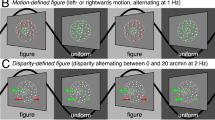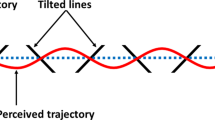Abstract
Borders defined by small changes in brightness (luminance contrast) or by differences in colour (chromatic contrast) appear to move more slowly than those defined by strong luminance contrast1,2,3,4. As spatial coding is influenced by motion5,6,7, if placed in close proximity, the different types of moving border might appear to drift apart8. Using this configuration, we show here that observers instead report a clear illusory spatial jitter of the low-luminance-contrast boundary. This visible interaction between motion and spatial-position coding occurred at a characteristic rate (∼ 22.3 Hz), although the stimulus motion was continuous and invariant. The jitter rate did not vary with the speed of movement. The jitter was not due to small involuntary movements of the eyes, because it only occurred at a specific point within the stimulus, the low-luminance-contrast boundary. These findings show that the human visual system contains a neural mechanism that periodically resolves the spatial conflict created by adjacent moving borders that have the same physical but different perceptual speeds.
This is a preview of subscription content, access via your institution
Access options
Subscribe to this journal
Receive 51 print issues and online access
$199.00 per year
only $3.90 per issue
Buy this article
- Purchase on Springer Link
- Instant access to full article PDF
Prices may be subject to local taxes which are calculated during checkout




Similar content being viewed by others
References
Anstis, S. Footsteps and inchworms: Illusions show that contrast affects apparent speed. Perception 30, 785–794 (2001)
Blakemore, M. R. & Snowden, R. J. The effect of contrast upon perceived speed: a general phenomenon? Perception 28, 33–48 (1999)
Cavanagh, P., Tyler, C. W. & Favreau, O. E. Perceived velocity of moving chromatic gratings. J. Opt. Soc. Am. A1, 893–899 (1984)
Thompson, P. Perceived rate of movement depends on contrast. Vision Res. 22, 377–380 (1982)
De Valois, R. L. & De Valois, K. K. Vernier acuity with stationary moving Gabors. Vision Res. 31, 1619–1626 (1991)
Nishida, S. & Johnston, A. Influence of motion signals on the perceived position of spatial pattern. Nature 397, 610–612 (1999)
Whitney, D. & Cavanagh, P. Motion distorts visual space: shifting the perceived position of remote stationary objects. Nature Neurosci. 3, 954–959 (2000)
Nguyen-Tri, D. & Faubert, J. The fluttering-heart illusion: a new hypothesis. Perception 32, 627–634 (2003)
Helmholtz, H. Treatise on Physiological Optics (Dover, New York, 1962)
von Grunau, M. W. The “fluttering heart” and spatio-temporal characteristics of color processing III. Interactions between the systems of the rods and the long-wavelength cones. Vision Res. 16, 397–401 (1976)
Bridgeman, B. & Stark, L. Ocular proprioception and efference copy in registering visual direction. Vision Res. 31, 1903–1913 (1991)
Sherrington, C. S. Observations on the sensual role of the proprioceptive nerve supply of the extrinsic ocular muscles. Brain 41, 332–343 (1918)
Wiesel, T. N. & Hubel, D. H. Spatial and chromatic interactions in the lateral geniculate body of the rhesus monkey. J. Neurophysiol. 29, 1115–1116 (1966)
Campbell, F. W., Robson, J. G. & Westheimer, G. Fluctuations of accommodation under steady viewing. J. Physiol. (Lond.) 145, 579–594 (1959)
Murakami, I. & Cavanagh, P. A jitter after-effect reveals motion-based stabilization of vision. Nature 395, 798–801 (1998)
Murakami, I. Illusory jitter in a static stimulus surrounded by a synchronously flickering pattern. Vision Res. 43, 957–969 (2003)
Von der Marlsburg, C. & Schneider, W. A neural cocktail-party processor. Biol. Cybern. 54, 29–40 (1986)
Engel, A. K., Konig, P., Kreiter, A. K. & Singer, W. Interhemispheric synchronization of oscillatory neuronal responses in cat visual cortex. Science 252, 1177–1179 (1991)
Engel, A. K. & Singer, W. Temporal binding and the neural correlates of sensory awareness. Trends Cogn. Sci. 5, 16–25 (2001)
Anstis, S. M. & Cavanagh, P. in Color Vision: Physiology and Psychophysics (eds Mollon, J. D. & Sharpe, L. T.) 155–166 (Academic, London, 1983)
Acknowledgements
We are grateful to C. Clifford, J. Dale, F. Kandil, S. Nishida and Q. Zaidi for their suggestions and comments.
Author information
Authors and Affiliations
Corresponding author
Ethics declarations
Competing interests
The authors declare that they have no competing financial interests.
Supplementary information
41586_2003_BFnature01955_MOESM1_ESM.zip
Supplementary Information: this zip file contains an executable file which demonstrates the apparent jitter of slow moving borders. (ZIP 10 kb)
Rights and permissions
About this article
Cite this article
Arnold, D., Johnston, A. Motion-induced spatial conflict. Nature 425, 181–184 (2003). https://doi.org/10.1038/nature01955
Received:
Accepted:
Issue Date:
DOI: https://doi.org/10.1038/nature01955
This article is cited by
-
Visual predictions, neural oscillations and naïve physics
Scientific Reports (2021)
-
Discretized Theta-Rhythm Perception Revealed by Moving Stimuli
Scientific Reports (2018)
Comments
By submitting a comment you agree to abide by our Terms and Community Guidelines. If you find something abusive or that does not comply with our terms or guidelines please flag it as inappropriate.



